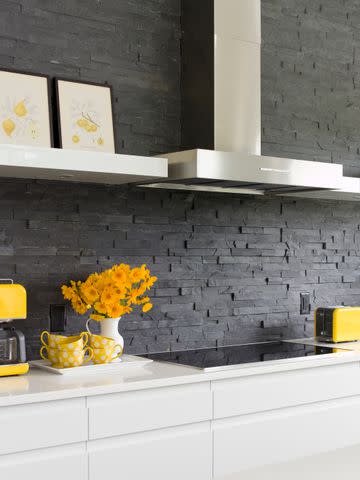Types of Range Hoods: A Guide to Kitchen Ventilation
Unsure which hood to buy for your cooktop? Here's a quick guide to kitchen ventilation options and factors to consider.

Annie Schlechter
Kitchens can get smoky, smelly, and hot. Proper ventilation allows comfortable use of your kitchen, regardless of what’s on the menu. Range hoods are integral to common kitchen ventilation systems. They work to remove smoke, airborne grease, and heat from cooktops. They can also enhance the aesthetic of your space by adding a dramatic focal point.
Types of range hoods include wall canopy, under-cabinet, and island canopy hoods. The best hood for your kitchen will depend on numerous factors, including size, layout, cooking preference, and cost. This guide to the different types of range hoods on the market can help you make an informed decision about which is best for your home.
Related: The 10 Best Range Hoods of 2023
Types of Range Hoods
There are many types of range, vent, and stove hoods that filter out unwanted kitchen heat, smoke, and odors. Common types of range hoods include:
Wall-Mount Canopy Range Hoods
These range hoods are typically mounted against the kitchen wall. They tend to be large enough to work for residential and commercial kitchens. The ideal distance between the bottom of the hood and the cooktop is between 28"–36" to capture the cooking fumes without damaging the range hood.
Under-Cabinet Range Hoods
Under-cabinet range hoods are installed under kitchen wall cabinets. These hoods have space-saving benefits. They are less bulky and can be seamlessly integrated into any kitchen design. They use a fan to draw in and filter dirty air, then vent the air outside through an exhaust fan. Some can recirculate clean air back into the kitchen. They are easy to install and cost-effective. Some models come with a light and energy-efficient capabilities. The downside is that they have limited ventilation power and can be quite noisy. Also, these types of hoods may not be very compatible with larger cooktops.
Chimney or Island Range Hoods
These range hoods are typically installed on the ceiling, directly above a stove or cooktop built into a kitchen island. These hoods offer a flexible kitchen design. Compared to ducted island range hoods, the ductless ones are easy and inexpensive to install.
Over-the-Range Hoods or Micro Hoods
These range hoods are built into the microwave. They are placed above the stove or cooktop and act as a range hood. This type of hood can either be ducted or ductless. However, it requires at least 16 vertical inches between the bottom of the microwave and the top of the stove or cooktop.
Downdrafts
Downdrafts are ideal for kitchens that cannot spare upper cabinet or ceiling space. They usually remain hidden, integrated into the stove, or installed separately. Smoke and odors are sucked downwards and vented out through ductwork beneath the floor. Recirculating or ductless kits are also available.

Laurie Black
Factors to Consider When Choosing Kitchen Ventilation
Venting Strength (CFM Rating)
Range hoods come in various shapes, sizes, and venting powers. The strength of venting is measured in cubic feet per minute (CFM), which represents the volume of air in cubic feet that the fan can remove from the kitchen each minute. Cooktops are measured by the British thermal units (BTU) of energy they produce. The general rule of thumb is that for every 100 BTU, you need 1 CFM. Cooktop manufacturers typically specify the CFM each range hood should have. However, a ventilation system with a high CFM rating is always a good idea, as cooking styles and frequencies can vary greatly.
Venting Options
After choosing the type of range hood, you'll need to select the venting option: external (ducted), recirculating (ductless), or convertible ventilation. Ducted hoods work by pushing air out of the house through ductwork in the wall or ceiling. Ductless hoods pass air through a filter before recirculating it back into the room. A convertible range hood is a hybrid with external venting and recirculating capabilities.
Size and Fit
The width of your vent hood should be slightly larger than your stovetop. Rather than an exact match, you’ll want the hood to be 3 inches larger on each side for complete coverage and optimal venting.
Installation
By definition, any kind of ductless range hood is easier to install than any ducted unit, which requires professional installation. For DIYers, ductless hoods, such as canopy and microwave hoods, are simple to install.
Filtration System
Mesh filters consist of layers of stacked metal mesh. They are hard to clean and can deteriorate quickly over the long-term. Slow extraction and loud noises indicate that the filter isn’t fully clean. Baffle filters are usually made with a higher-quality metal, such as stainless steel, mild steel, or aluminum. Charcoal filters do not need to be cleaned but require replacement after about 120 hours of cooking or every 3 to 6 months.
Cost
For a limited budget, one-speed recirculating canopy units offer a great value at as little as $50. The price can go up to $6,000 for artisan-grade, riveted, and hammered copper range hoods. Every price point in between can offer featues that determine noise levels, styles, flexibility of hood inserts, material used, automatic speed level adjustment, and lighting.
For more Better Homes & Gardens news, make sure to sign up for our newsletter!
Read the original article on Better Homes & Gardens.

